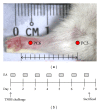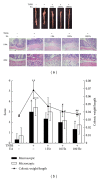Electroacupuncture improves trinitrobenzene sulfonic Acid-induced colitis, evaluated by transcriptomic study
- PMID: 24995035
- PMCID: PMC4068094
- DOI: 10.1155/2014/942196
Electroacupuncture improves trinitrobenzene sulfonic Acid-induced colitis, evaluated by transcriptomic study
Abstract
Inflammatory bowel disease is a chronic colonic inflammation that displays symptoms like diarrhea and weight loss. Acupuncture has been widely accepted by Western countries for the treatment of pain. Here, we analyzed efficacy and mechanism of electroacupuncture (EA) on trinitrobenzene sulfonic acid- (TNBS-) induced colitis in mice. Mice were intrarectally administered with 250 mg/kg TNBS and electroacupunctured at Quze (PC3) and Neiguan (PC6) acupoints, which have been applied for gastrointestinal disorders. Gene expression profiles in colons and spleens were analyzed by microarray for the elucidation of mechanism of EA. Our data showed that EA at PC3 and PC6 improved macroscopic and microscopic features of colitis and the improvement displayed a frequency-dependent manner. Administration of TNBS upregulated the expression of most cytokine genes in colons, while EA downregulated the expression of TNBS-induced cytokine genes. Pathway analysis showed that EA significantly affected inflammatory pathways in colons and immunity-associated pathway in spleens. Immunohistochemical staining further showed that EA decreased the expression of interleukin-1 β and nuclear factor- κ B. In conclusion, this is the first study reporting the global gene expression profiles of EA on TNBS-induced colitis. Our findings suggested that inflammatory and immunity pathways were involved in the anti-inflammatory mechanism of EA on colitis induced by TNBS.
Figures




Similar articles
-
Anti-inflammatory effects and mechanisms of vagal nerve stimulation combined with electroacupuncture in a rodent model of TNBS-induced colitis.Am J Physiol Gastrointest Liver Physiol. 2017 Sep 1;313(3):G192-G202. doi: 10.1152/ajpgi.00254.2016. Epub 2017 May 25. Am J Physiol Gastrointest Liver Physiol. 2017. PMID: 28546285
-
[Effect of Electroacupuncture and Manual Acupuncture on Colonic Inflammatory Injury, Cytokine Levels and Cell Apoptosis in Ulcerative Colitis Rats].Zhen Ci Yan Jiu. 2017 Feb 25;42(1):56-61. Zhen Ci Yan Jiu. 2017. PMID: 29071999 Chinese.
-
Efficacy of thalidomide on trinitrobenzene sulfonate-induced colitis in young rats and its mechanism.Chin Med J (Engl). 2014;127(12):2368-75. Chin Med J (Engl). 2014. PMID: 24931258
-
[Acupuncture reduce colonic inflammation by suppressing oxidative stress and endoplasmic reticulum stress in rats with ulcerative colitis].Zhen Ci Yan Jiu. 2020 Jan 25;45(1):8-13. doi: 10.13702/j.1000-0607.1806066. Zhen Ci Yan Jiu. 2020. PMID: 32144902 Chinese.
-
Preclinical Study in Vivo for New Pharmacological Approaches in Inflammatory Bowel Disease: A Systematic Review of Chronic Model of TNBS-Induced Colitis.J Clin Med. 2019 Oct 1;8(10):1574. doi: 10.3390/jcm8101574. J Clin Med. 2019. PMID: 31581545 Free PMC article. Review.
Cited by
-
Acupuncture at Back-Shu and Front-Mu Acupoints Prevents Gastric Ulcer by Regulating the TLR4/MyD88/NF-κB Signaling Pathway.Evid Based Complement Alternat Med. 2021 Feb 9;2021:8214052. doi: 10.1155/2021/8214052. eCollection 2021. Evid Based Complement Alternat Med. 2021. PMID: 33628315 Free PMC article.
-
Changes in Acupuncture-Induced Specific Acupoint Neurotransmitters are Possibly Related to Their Physiological Functions in Rats.Evid Based Complement Alternat Med. 2023 Feb 21;2023:4849528. doi: 10.1155/2023/4849528. eCollection 2023. Evid Based Complement Alternat Med. 2023. PMID: 36865739 Free PMC article.
-
Comprehensive evaluation of gene expression signatures in response to electroacupuncture stimulation at Zusanli (ST36) acupoint by transcriptomic analysis.BMC Complement Altern Med. 2017 Aug 15;17(1):406. doi: 10.1186/s12906-017-1911-0. BMC Complement Altern Med. 2017. PMID: 28810910 Free PMC article.
-
Electroacupuncture therapy in inflammation regulation: current perspectives.J Inflamm Res. 2018 May 17;11:227-237. doi: 10.2147/JIR.S141198. eCollection 2018. J Inflamm Res. 2018. PMID: 29844696 Free PMC article. Review.
-
Risk for Irritable Bowel Syndrome in Fibromyalgia Patients: A National Database Study.Medicine (Baltimore). 2017 Apr;96(14):e6657. doi: 10.1097/MD.0000000000006657. Medicine (Baltimore). 2017. PMID: 28383443 Free PMC article.
References
-
- Ahuja V, Tandon RK. Inflammatory bowel disease in the Asia-Pacific area: a comparison with developed countries and regional differences. Journal of Digestive Diseases. 2010;11(3):134–147. - PubMed
-
- Friedman S, Blumberg RS. Inflammatory bowel disease. In: Longo DL, Fauci AS, Kasper DL, Hauser SL, Jameson JL, Loscalzo J, editors. Harrison’s Principles of Internal Medicine. 18th edition. New York, NY, USA: McGraw-Hill; 2012.
-
- Engel MA, Neurath MF. New pathophysiological insights and modern treatment of IBD. Journal of Gastroenterology. 2010;45(6):571–583. - PubMed
-
- Ben-Horin S, Kopylov U, Chowers Y. Optimizing anti-TNF treatments in inflammatory bowel disease. Autoimmunity Reviews. 2014;13(1):24–30. - PubMed
-
- Antoni C, Braun J. Side effects of anti-TNF therapy: current knowledge. Clinical and Experimental Rheumatology. 2002;20(6, supplement 28):S152–S157. - PubMed
LinkOut - more resources
Full Text Sources
Other Literature Sources
Molecular Biology Databases

